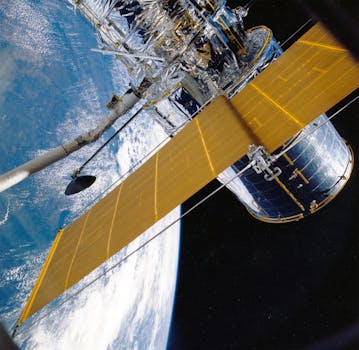GEO Satellites: Understanding the Technology and Applications of Geostationary Earth Orbit Satellites
GEO satellites are a crucial part of modern telecommunications, providing a wide range of services including television broadcasting, internet connectivity, and weather forecasting. In this article, we will explore the technology and applications of geostationary earth orbit satellites.

GEO Satellites: Understanding the Technology and Applications of Geostationary Earth Orbit Satellites
GEO satellites, or geostationary earth orbit satellites, are a type of satellite that orbits the Earth at an altitude of approximately 36,000 kilometers, allowing them to remain stationary in relation to a fixed point on the Earth’s surface. This unique characteristic makes GEO satellites ideal for a wide range of applications, including telecommunications, weather forecasting, and space exploration.
The technology behind GEO satellites is complex and involves a number of key components, including the satellite itself, the launch vehicle, and the ground control system. The satellite is equipped with a range of instruments, including transponders, antennas, and solar panels, which allow it to receive and transmit signals, as well as generate power. The launch vehicle is used to place the satellite into orbit, and the ground control system is used to monitor and control the satellite’s operations.
The History of GEO Satellites
The concept of GEO satellites was first proposed by scientist Arthur C. Clarke in 1945, and the first GEO satellite, Syncom 2, was launched in 1963. Since then, hundreds of GEO satellites have been launched, providing a wide range of services, including television broadcasting, internet connectivity, and weather forecasting. Today, GEO satellites play a vital role in modern telecommunications, and are used by governments, businesses, and individuals around the world.
The applications of GEO satellites are diverse and continue to expand. One of the most significant applications is telecommunications, where GEO satellites are used to provide internet connectivity, telephone services, and television broadcasting. GEO satellites are also used for weather forecasting, allowing meteorologists to track storms and predict weather patterns. In addition, GEO satellites are used for space exploration, providing scientists with valuable data about the Earth’s atmosphere and the universe.
The Benefits and Challenges of GEO Satellites
The benefits of GEO satellites are numerous, and include the provision of global coverage, high bandwidth, and reliability. GEO satellites can provide coverage to remote and underserved areas, where traditional telecommunications infrastructure is limited or non-existent. They can also provide high-speed internet connectivity, allowing users to access a wide range of online services. However, GEO satellites also face a number of challenges, including signal latency, interference, and orbital congestion.
Signal latency is a significant challenge for GEO satellites, as it can take several seconds for signals to travel from the Earth to the satellite and back again. This can make real-time applications, such as video conferencing, difficult to implement. Interference is also a challenge, as GEO satellites can be affected by signals from other satellites and terrestrial sources. Orbital congestion is another challenge, as the number of GEO satellites in orbit continues to increase, making it difficult to find available slots and avoid collisions.
The Future of GEO Satellites
The future of GEO satellites is exciting and rapidly evolving. New technologies, such as high-throughput satellites and advanced propulsion systems, are being developed to improve the performance and efficiency of GEO satellites. In addition, the use of GEO satellites for emerging applications, such as the Internet of Things (IoT) and 5G networks, is expected to drive growth and innovation in the industry.
However, the future of GEO satellites also poses a number of challenges, including the need for sustainable and responsible practices, as well as the mitigation of orbital debris and other environmental impacts. As the number of GEO satellites in orbit continues to increase, it is essential that we develop and implement sustainable and responsible practices, to ensure the long-term viability of the technology.




